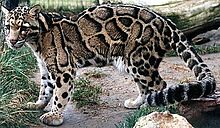Stóru Kattardýrin/Niflhlébarði

Ekki mikið er vitað um Niflhlébarða nema að þeir eru ekki raunverulegir hlébarðar en eyða mestum sínum tíma í trjám rétt eins og nafnar þeirra í Afríku gera.
Heimkynni
[breyta]
Niflhlébarðar lifa þvert í gegnum Suður Kína, austur himalæjafjöll og suðaustur Asíu auk hluta af Indónesíu. Þeir vilja helst lifa í hitabeltisskógum en finnast samt á fenjasvæðum og graslendum.
Útlit
[breyta]
Fullorðinn Niflhlébarði er getur verið allt frá 61 cm að lengd frá nefi til bossa að 92 cm. Niflhlébarðinn er með frekar stuttar lappir miðað við stærð en hafa hins vegar lengstu vígtennur lifandi dýra eða um 5,1 cm að lengd. Aðeins hinir útdauðu Vígtannar höfðu stærri tennur miðað við líkamsstærð.
Clouded leopards are excellent climbers and their major prey animals live in trees. Short, flexible legs, large paws, and keen claws combine to make them very sure-footed in this environment. The clouded leopard's tail can be as long as its body and helps to maintain the cat's balance while moving through the trees. Amazingly, these cats can hang upside-down under branches, and can even climb down tree trunks head-first. Other cats cannot do this because their claws are not shaped in the same way.
The beautiful pattern of the clouded leopard's fur is its most interesting feature. The large square rosettes look like clouds to some people, and that is how they got the name "clouded leopard." Other people think the blotches look more like mint leaves, so they are also called "mint leopards."
What do clouded leopards eat, and how do they catch their prey?
[breyta]While not much is known about their behaviour in the wild, their prey is thought to be mostly mammals that live in trees, particularly monkeys, along with small mammals, deer, birds, porcupines, and domestic livestock.
Fun facts
[breyta]See how much you know about the clouded leopard:
- They can climb down tree trunks head first.
- Like marbled cats and margays, they will sometimes hang head-down from branches using their hind legs.
- Young clouded leopards are born with spots that become open squares as they grow older.
